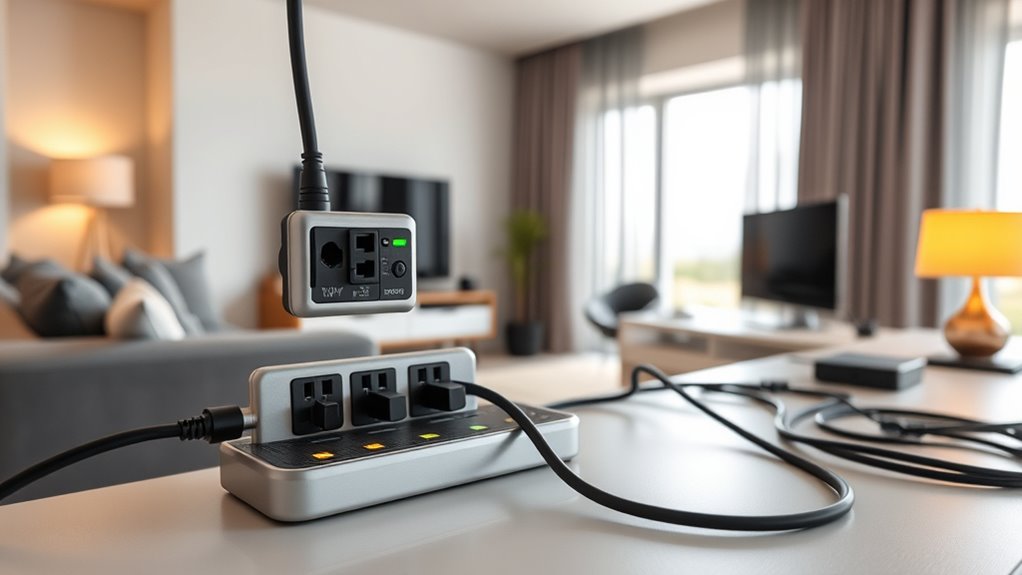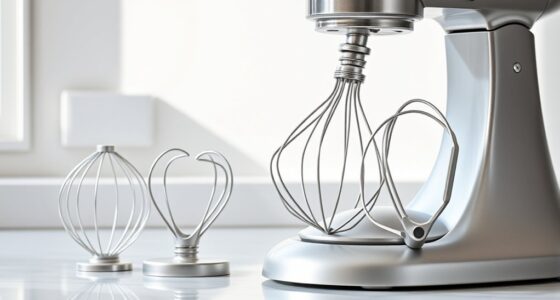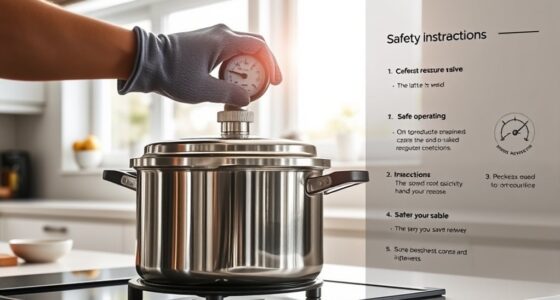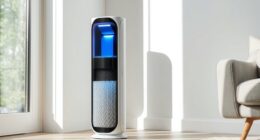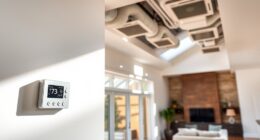When choosing a surge protector for your home appliances, focus on a high joule rating for better energy absorption and a low clamping voltage for quicker response. Make certain it has indicator lights to confirm protection is active and a grounding plug for safety. Consider additional features like USB ports or warranties for peace of mind. Picking the right model keeps your devices safe; stay with us to explore key details to help make the best choice.
Key Takeaways
- Check the joule rating to ensure sufficient energy absorption for your appliances’ safety.
- Look for a low clamping voltage (≤400V) for quicker surge response.
- Confirm the surge protector has indicator lights and a good warranty for ongoing protection.
- Ensure the plug is properly grounded to safely dissipate excess voltage.
- Consider additional features like USB ports and the number of outlets to suit your needs.
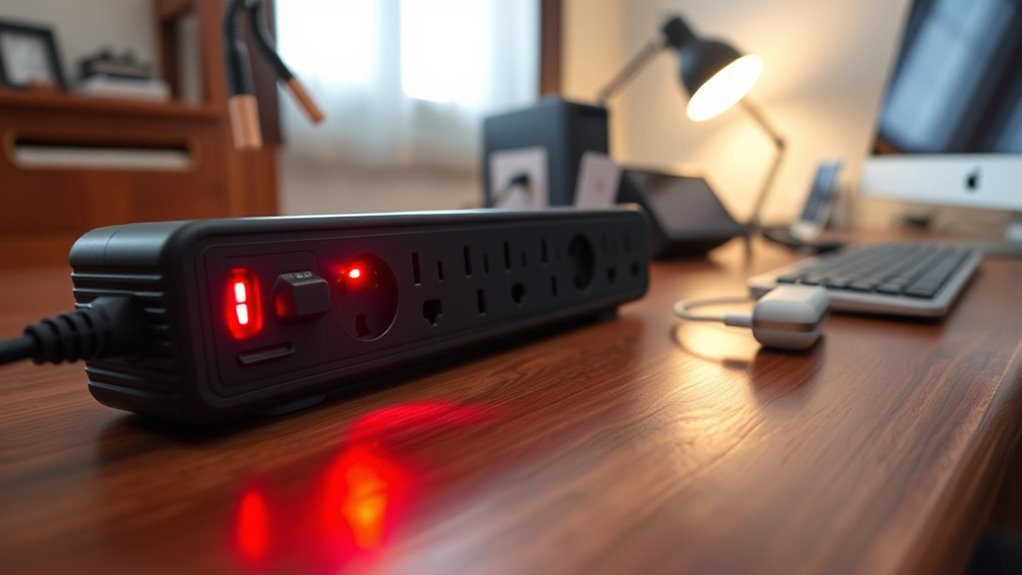
When it comes to protecting your electronic devices, choosing the right surge protector is indispensable. Power surges can happen unexpectedly, often caused by lightning strikes, power outages, or fluctuations in the electrical grid. These sudden spikes in voltage can damage your appliances or shorten their lifespan, making it imperative to select a surge protector that offers reliable electrical safety. Your goal is to prevent costly repairs or replacements, so understanding what features to look for is key.
Protect your devices from unexpected power surges with a reliable surge protector.
First, consider the surge protector’s joule rating, which indicates how much energy it can absorb before failing. A higher joule rating provides better protection against larger power surges, especially if you have sensitive or expensive electronics like computers or home entertainment systems. Don’t settle for a low rating; investing in a model with a robust joule capacity ensures your devices are shielded against the most damaging surges.
Next, look at the clamping voltage, or voltage suppression level. This rating shows at what voltage the surge protector will start diverting excess current away from your devices. A lower clamping voltage means better protection because it activates sooner during a power spike. For electrical safety, aim for devices that clamp at 400V or less, providing a quick response to surges and reducing the risk of damage.
Also, check for features like indicator lights, which confirm whether the surge protection is active. Some models include warranties or equipment protection policies, offering additional peace of mind. Remember, surge protectors are not designed to last forever; their components degrade over time, especially after multiple surges. An indicator light can help you know when it’s time to replace your unit to maintain essential electrical safety.
Furthermore, understanding the importance of projector technology, such as the role of contrast ratio, can help you choose surge protectors that are better suited for your home entertainment setup, ensuring your devices operate smoothly without interruptions. Port selection and cord length are practical considerations too. Choose a surge protector with enough outlets for your needs, and ensure it has a sturdy, grounded plug. Grounding is indispensable for electrical safety because it provides a safe path for excess voltage to dissipate, protecting your devices and reducing the risk of electric shocks. Many surge protectors also come with features like USB ports or cord management systems, adding convenience without compromising protection.
Frequently Asked Questions
Can Surge Protectors Prevent All Power Surges?
Surge protectors can’t prevent all power surges, despite power surge myths suggesting they can. They’re effective against small to moderate surges, but large ones might still cause damage. Proper surge protector installation is vital for maximum protection. Remember, no device offers 100% protection, so consider additional measures like whole-house systems. Always research and select high-quality surge protectors to maximize your home’s safety and reduce the risk of appliance damage.
How Do I Know if a Surge Protector Is Certified?
You can tell if a surge protector is certified by looking for certification labels, such as UL approval, on the device. These labels indicate the product has been tested and meets safety standards. Always check for a genuine UL mark, which means the surge protector has undergone rigorous testing. Avoid uncertified options, as they may not provide reliable protection or could pose safety risks.
What’s the Lifespan of a Typical Surge Protector?
A typical surge protector lasts about 3 to 5 years, depending on its durability and how often you use it. You can estimate its lifespan by checking for signs of wear, such as frayed cords, damaged outlets, or burned smells. Regularly testing the indicator lights helps guarantee it’s functioning properly. By monitoring its condition, you extend its durability and maintain reliable protection, making your investment last longer.
Are There Specific Surge Protectors for Sensitive Electronics?
Yes, there are electronic-specific surge protectors designed to safeguard sensitive devices like computers and audio equipment. These protectors offer advanced features such as cleaner power regulation and lower let-through voltage, ensuring sensitive device protection. When choosing, look for models with high joule ratings and UL 1449 certification, which indicate reliable protection. Using the right surge protector minimizes risks of damage caused by power surges, keeping your electronics safe and functioning properly.
Can I Connect Multiple Surge Protectors Together?
You should avoid daisy chaining multiple surge protectors, as it can cause power distribution issues and increase the risk of overload or fire. Connecting surge protectors together doesn’t improve protection; instead, it can compromise safety. Instead, use a single, high-quality surge protector with enough outlets and adequate joule ratings for your devices. This ensures proper power distribution and reliable protection for all your appliances without risking safety.
Conclusion
Choosing the right surge protector can save your valuable appliances during unexpected power surges. Did you know that a single lightning strike can cause up to $10,000 in damage? By selecting a surge protector with the right Joule rating and features, you’re protecting your home and saving money in the long run. Don’t wait for a surge to strike—invest now and keep your appliances safe and secure.
